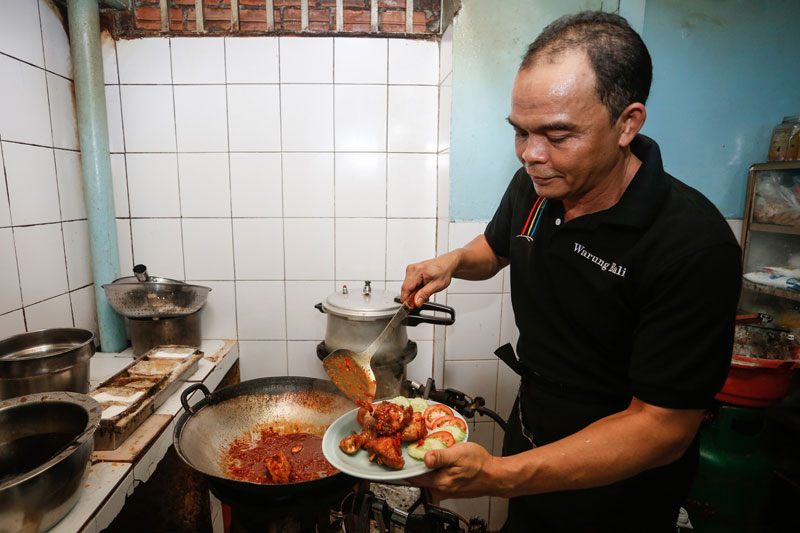When asked to prepare one of his favorite recipes, Indonesian chef Firdaus immediately selected “ayam bumbu Bali,” a traditional dish from the island of Bali.
The word “ayam” means chicken in Indonesian, while “bumbu Bali” translates to “Balinese spices.” It is this mixture of spices that sets ayam bumbu Bali apart from other Indonesian chicken recipes, which is why Mr. Firdaus included it on the menu at his restaurant in Phnom Penh, Warung Bali.

To make the dish, Mr. Firdaus, who like many Indonesians goes only by one name, starts by preparing the sauce.
“Shallots, garlic, chili and then peanut sauce made from whole peanuts, sweet soya sauce, white pepper and then salt,” he said. “If you don’t have soya sauce, you can use brown sugar.” These ingredients are blended together into a sauce.
Next, Mr. Firdaus fries chunks of chicken in a small amount of oil in a wok over extremely high heat for about five minutes. He then pours the sauce over the chicken in the pan, adds some peanuts and slivers of red pepper and shallots, and cooks the dish for another minute before serving.
Mr. Firdaus selected the recipes for Warung Bali’s menu with a clear vision: “I want to serve Indonesian food from different islands,” he said.
And that is no small task. Indonesia is the fourth-most populous country in the world—after China, India and the U.S.—with 255 million people living on about 6,000 inhabited islands.
“We have 300 languages, and the food is very different in each island, different traditions,” Mr. Firdaus said.
However, he noted that one ingredient is consistently found in all types of Indonesian cuisine: red chili.

Born in 1966 in Karawang, near Jakarta, Mr. Firdaus is a self-taught chef. “I liked to cook as a child,” he said. His mother encouraged him to keep on practicing so that one day he could become a professional.
Instead, Mr. Firdaus went on to study accounting and bookkeeping at a business school in Jakarta and, in 1985, began working an office job. But after his boss found out that he liked cooking, he also encouraged him to follow his passion.
This led him to apply for the chef position at the Indonesian Embassy in Cambodia, which he landed in 1993. By 2000, having cooked for three Indonesian ambassadors in Phnom Penh, Mr. Firdaus was ready for a change.
Through the embassy, he met Kasmin, an Indonesian man who came to Cambodia in 1996 to work for a telecommunications company. Originally fr om Cilacap in Central Java, Mr. Kasmin had also studied accounting and loved to cook.
In 2000, Mr. Kasmin’s boss at the telecom company opened Bali Cafe in Phnom Penh and hired Mr. Firdaus as chef and Mr. Kasmin as manager. In 2007, she returned to Indonesia, but left behind the restaurant equipment for the two friends to use, Mr. Kasmin said.
So they opened their restaurant near the National Museum with a modest Southeast Asian design and low prices, and trained Cambodian staff to assist Mr. Firdaus.
Today, the restaurant’s clientele is a mix of Western expatriates and tourists, and customers from throughout Southeast Asia, Mr. Kasmin said. It has also become a meeting place for the city’s Indonesian community.



